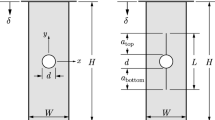Abstract
The strain fields ahead of crack tips in rock, mortar, and graphite were measured using a photoelastic coating method. A transparent ferroelectric ceramic was used as a coating material to observe the photoelastic fringe pattern. A coating plate of 110–150 μm thick was placed on single-edge-notch specimens, and photoelasticity experiments were conducted in three-point bending under a polarizing microscope. The results show that the principal-strain difference ahead of the crack tip is given by
whereσ ult is the ultimate tensile strength,r is the distance from the crack tip, and9ɛ o andm are material constants. Based on this observation, the use of theJ Ic concept in determining the fracture toughness of brittle-microcracking materials is discussed.
Similar content being viewed by others
References
Ouchterlony, F., “Fracture Toughness Testing of Rock,”Rock Fracture Mechanics, Springer-Verlag, New York, 69–150 (1983).
Higgins, D.D. andBailey, J.E., “Fracture Measurement on Cement Paste,”J. Mater. Sci.,11,1995–2003 (1967).
Schmidt, R.A. and Lutz, T.J., “K Ic and JIc of Westerly Granite-Effect of Thickness and In-Plane Dimensions,” Fracture Mechanics Applied to Brittle Materials, Proc. 11th Nat. Symp. on Fracture Mechanics: Part II, STP, 678, Amer. Soc. for Test. and Mat., Philadelphia, 166–182 (1979)x.
Hashida, T., Yuda, S., Tamakawa, K. and Takahashi, H., “Determination of Fracture Toughness of Granitic Rock by Means of AE Technique,” Progress in Acoustic Emission, Proc. 6th Int. AE Symp., Susono, Japan, 78–89 (1982).
Mindess, S., Lawrence, F.V. andKesler, C.E., “The J-integral as a Fracture Criterion for Fiber Reinforced Concrete,”Cem. Conc. Res.,7 (6),731–742 (1977).
Hashida, T. andTakahashi, H., “Fracture Toughness Determination of Concrete and Reactor Surveillance Procedure by Use of Breakoff Tester and Acoustic Emission Technique,”Trans. 9th Int. Conf. Struct. Mech. in Reactor Tech.,A,187–192 (1987).
American Society for Testing and Materials, “Standard Test Method for J.Ic, A Measure of Fracture Toughness,” ANSI/ASTM E813-87, Annual Book of Standards, 03.01 (1987)
Srawley, J.E., “On the Relation of J I to Work Done Per Unit Uncracked Area: ‘Total’, or Component ‘Due to Crack’,”Int. J. Fract.,12,470–474 (1976).
Niitsuma, H., Kikuchi, K., Takahashi, H., Suzuki, M. and Sato, R., “AE Classification and Micro Pop-in Cracking in Fracture Toughness Test,” Proc. 5th Int. Symp. Acoustic Emission, Tokyo, 411–420 (1980).
Takahashi, H., Khan, M.A., Kikuchi, M. andSuzuki, M., “Acoustic-Emission Crack Monitoring in Fracture-Toughness Test for AISI 4340 and SA533B Steels,”Experimental Mechanics,21,89–99 (1981).
Kishitani, K., Hirai, T. andMurakami, K., “Study on Estimation of Fracture Toughness for Concrete-Indirect Estimation Based on Fracture Model Analysis,”J. Struct. and Construction Eng. (Trans. Arch. Inst. of Japan) in Japanese, 360, 10–15 (1986).
Rice, J.R. andJohnson, M.A., “Role of Large Crack Tip Geometry Changes in Plane Strain Fracture,”Inelastic Behavior of Solids, McGraw-Hill, London and New York, 641–672 (1970).
Shoji, T., “Crack Tip Blunting and Crack-Opening Displacement under Large-Scale Yielding,”Met. Sci.,10,165–169 (1976).
Labuz, J.F., Shah, S.P. andDowding, C.H., “Experimental Analysis of Crack Propagation in Granite,”Int. J. Rock Mech. Min. Sci.,22,85–98 (1985).
Ingraffea, A.R. and Schmidt, R.A., “Experimental Verification of a Fracture Mechanics Model for Tensile Strength Prediction of Indiana Limestone,” Proc. 19th U.S. Symp. on Rock Mech., Univ. of Nevada, Reno, 247–253 (1978).
Hillerborg, H., “Analysis of One Single Crack,” Fracture Mechanics of Concrete, Elsevier Science Publishers B.V., 223–249 (1983).
Swanson, P.L., “Tensile-Fracture Resistance Mechanism in Brittle Polycrystals: An Ultrasonics and In-Situ Microscopy Investigation,”J. Geophygical Res., 92, 8015–8036 (1987).
Nolen-Hoeksema, R.C. andGordon, R.B., “Optical Detection of Crack Patterns in the Opening-Mode Fracture of Marble,”Int. J. Rock Mech. Min. Sci. & Geomech. Abstr.,24,135–144 (1987).
Author information
Authors and Affiliations
Rights and permissions
About this article
Cite this article
Hashida, T. Characterization of crack-tip strain singularity in brittle-microcracking materials by means of the photoelastic-coating method. Experimental Mechanics 29, 307–311 (1989). https://doi.org/10.1007/BF02321413
Received:
Revised:
Issue Date:
DOI: https://doi.org/10.1007/BF02321413




